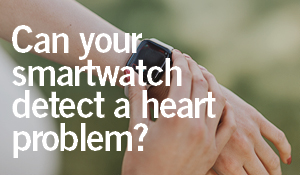The evolution of smartwatches has ushered in a new era of personalized health monitoring. Many of these devices now come equipped with an electrocardiogram (ECG) feature, allowing wearers to independently record their heart’s rhythm.
This was the case for Val Chaban, a retired law enforcement officer from Lodi, who noticed that he was frequently experiencing a subtle but persistent fluttering sensation in his chest after his routine workouts.
“I would be sitting or lying down and I would feel palpitations,” said Val. “It became very concerning to me, so I started checking my heart rate on my smartwatch.”
For Val, this technology provided a crucial breakthrough. His smartwatch detected an elevated heart rate, signaling him to reach out to his health care team, including Uday Sandhu, MD, an electrophysiologist at Dignity Health Mercy Medical Group in Stockton.
“I was able to present very clear information to my doctor,” said Val. “Being able to show my doctor exactly what was happening with data was empowering.”
 This real-time insight from Val’s device provided a valuable foundation for Dr. Sandhu to diagnose Val for supraventricular tachycardia (SVT), or an abnormally fast heart rate. Using a minimally invasive ablation procedure, Dr. Sandhu and his team were able to restore the heart’s normal rhythm, allowing Val to return to his regular life, including his workout routine.
This real-time insight from Val’s device provided a valuable foundation for Dr. Sandhu to diagnose Val for supraventricular tachycardia (SVT), or an abnormally fast heart rate. Using a minimally invasive ablation procedure, Dr. Sandhu and his team were able to restore the heart’s normal rhythm, allowing Val to return to his regular life, including his workout routine.
Smartwatches can detect AFib
Dr. Sandhu has witnessed a surge in patients bringing forth alerts and data from their smartwatches. Along with detecting an elevated heart rate, these wearable monitors have the potential to uncover atrial fibrillation (AFib), an irregular heartbeat that causes the heart to beat too fast, or too slow.
Detecting AFib early means that treatment can start early, which lowers risk factors for cardiovascular disease and stroke. Yet, Dr. Sandhu cautions against exclusive reliance on smart devices.
“Be sure to keep up on regular visits with your doctor,” said Dr. Sandhu. “Always mention feelings of fluttering or beat skipping — even if your smart device has not detected anything unusual.”
Seek medical attention if you have any of these signs of an irregular heart rhythm:
- Palpitations/fluttering sensations
- Dizziness or feeling lightheaded
- Fainting
- Pounding in your chest
- Shortness of breath
- Chest pain or tightness
- Fatigue or exhaustion
- Anxiety
When monitoring your heart rate consult your doctor if:
- You have an elevated heart rate that lasts longer than a few minutes while resting
- You have a heart rate that is greater than 100 beats per minute at rest
- You or your device detect an irregular rhythm
Val’s experience highlights the potential life-saving capabilities of smartwatch technology in monitoring heart health. Through vigilant self-monitoring, he was able to detect and address a concerning issue with his heart rhythm. The data provided by his smartwatch empowered him to have a productive conversation with his healthcare team, ultimately leading to a diagnosis and effective treatment.
Dr. Sandhu emphasizes the importance of early detection, particularly for conditions AFib, which can lead to serious complications if left untreated. While smartwatches are valuable tools, they should complement, not replace, regular visits to a health care team. Any unusual symptoms, such as fluttering sensations, rapid or irregular heartbeats, should be promptly discussed with a doctor, even if they haven’t been detected by a smart device.






More Stories
Thoughts as of late: on evolving, growing & that tiny voice inside
County Health Officials Report 17% Increase in Tuberculosis Cases
10 Most Nutrient-Rich Foods To Include In Your Diet